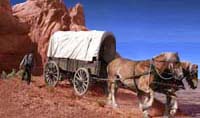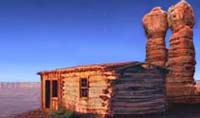 Return to Biography Selections
Return to Biography Selections |
 Download a Printable
Download a Printable
PDF File |
James Monroe Redd
Born: 24 August 1863; New Harmony, Washington, Utah
Died: 30 May 1937
Married: Lucinda Alvia Pace; 2 April 1884; St. George Temple, St. George, Washington, Utah
Father: Lemuel Hardison Redd, Sr.
Mother: Keziah Jane Butler
Childhood
James Monroe Redd, or Monroe, as he was called by most, was born to the delight of his parents, Lemuel Hardison Redd, Sr. and Keziah Jane Butler on August 24, 1863, in New Harmony, Utah. He had a happy, active childhood racing across the plains and working on the farm with his nine other brothers and sisters. In 1866, when Monroe was three years old, his father entered into a polygamous marriage with Sarah Jane Chamberlain. They all lived together for four years until the little house could no longer contain so many busy bodies. (Lemuel Redd Sr. and Sarah Jane had 12 children, so life on the Redd family homestead was bustling!) Monroe’s father bought a large duplex and for the next 20 years, the two families lived side by side. There was always someone for Monroe to play with, share in his chores and explore the wilderness with. Monroe lived, worked, learned and played on this homestead until he was 17 years old. At that time, President Brigham Young called a company of young men and families to colonize the San Juan area of southern Utah and Monroe Redd was among them.
Hole-in-the-Rock
In November 1879, Monroe joined his father, older brother, Lemuel Redd, Jr., and many others, on what would become a journey of a lifetime. They left New Harmony and headed east for San Juan County. “They traveled the old road to Panguitch, down East Fork to sweet water and over the Wasatch Range down to Escalante.” i There they met up with approximately 80 more wagons that had gathered from various parts of southern Utah to join the expedition. The group traveled to Forty-mile Spring, then Fifty-mile Spring, where they found Silas Smith and his company, brainstorming ideas on how to cross the Colorado River. After sending scouts up the river to find a better place to cross, the party concluded there was not one nearby. They put together a second scouting party, consisting of Monroe’s father, and three other men, and provisioned them to go farther down the river in search of a safe spot to cross. It was anticipated that they would find what they were looking for and return in about eight days. Instead, their journey took twenty-five. Undoubtedly, Monroe and his brother Lemuel were gravely concerned for their father’s safety and whereabouts, and were overjoyed when he finally rode back into camp. Their joy became even sweeter when Monroe’s father shared the good news that a way to cross the Colorado had been found.
Confident that the river could be crossed, now they just had to get all the wagons, people and animals downto it. They began by blasting a hole in the canyon wall, wide enough that wagons could fit through one at a time. After working tirelessly for seven or eight weeks, the Hole-in-the-Rock was ready. Monroe was in charge of overseeing the cattle and horses during their journey, and his job now was to help them down the rocky incline. They went last, after all the wagons had descended and crossed the river. Once the arduous task of getting the oxen to the river was completed, the animals seemed to understand the exhilaration of what they had just accomplished. Instead of waiting to be ferried across on the raft, they plunged right into the water, still yoked together. The oxen were so excited to be swimming across the cool water that they “snorted so loudly that the camp became panic stricken with the women rushing to the wagons fearing that a bear-like monster was after them.” ii It was a long, slow journey traveling with so many people. They were blazing unbroken terrain, and thus had to stop often to forge a trail or road so they could get through. When grass and feed became scarce, Monroe would separate from the company in order to find enough food for the cattle and horses.
After traveling six months, Monroe and the company of weary, happy travelers finally arrived in Bluff, Utah, on April 6, 1880. It was truly a day of rejoicing. Monroe stayed for a short time helping to set up a new life for those he had come to know and love. In June, he decided it was time to head home and returned to his family in New Harmony.
Marriage and Family Life
After he had been home for some time, James met the lovely Lucinda Alvia Pace. The daughter of James and Margaret Calhoun Pace, she too was born and raised in New Harmony. Monroe and Lucinda fell in love and were married in the St. George Temple on April 2, 1884. For the first three years of their marriage, they lived in New Harmony, where their first two children were born. In 1887, sensing greater business prospects farther south, Monroe moved his small family to Bluff. The journey was much easier this time! No holes to blast or roads to pave, and a safe, easy river crossing at Dandy (now called Hite).
The family’s “first home in Bluff was a log cabin with dirt floors where the family lived for six months. Later [Monroe] bought the home of Apostle Brigham Young, an acre of land and a three-room log house . . . for the fabulous sum of $250.00. This home was in the luxury class at that time.” iii
Monroe had enjoyed the work he did herding the cattle and horses during his adventure through the Hole-in-the-Rock, and decided to make a living at it. He joined with Joshua Stevens, Brigham Young, Jr., and Platte D. Lyman in raising cattle. Eventually, the people of Bluff bought out a cattle company from Texas, and Monroe joined the Bluff pool to help pay for it.
In 1905, Monroe and Lucinda decided to move to Monticello. Monroe was raised on a small farm with his brothers and sisters, and now that he had a growing family of his own, he decided to go back to farming. In total, he and Lucinda had nine children and a farm seemed like the best place to raise them.
Lucinda was a wonderful wife and mother and active member of her community. Among the many roles she played, one of the most important was that of an instinctive nurse. During an epidemic of typhoid fever that hit their small community, she nursed many people who became quite ill. When it was discovered that typhoid spread in the unclean water from their irrigation ditch, she and several other women made it their personal mission to see that a clean water system and electricity were installed in Monticello. They were successful and the quality of life drastically improved for the entire community. But that was not all. Proud of her pioneer heritage, “she helped to organize and was a charter member of the San Juan County Daughters of Utah Pioneers” in which she active until she died. iv Lucinda was also an advocate for education. She was a member of the San Juan County School Board, and saw to it that her children got the best education they could. Seven of them went on to attend college. Clearly, Lucinda was a force for good in any endeavor she pursued.
In addition to being a community activist, faithful wife and mother, Lucinda was a welcoming hostess. “For many years the community had no public eating place so her home was open to hungry and tired travelers, usually free of charge. The guests she entertained ran the gamut from high Church and state officials to a humble hungry Navajo.” v
Lucinda’s responsibilities never seemed to cease from mounting, and she never seemed to tire of their weight, even when she bore them alone. For two years, she managed alone the business affairs, household duties and child rearing, while her dear husband served a mission for the Church.
Missionary and Church Service
In 1899, Monroe was called formally to serve a mission for The Church of Jesus Christ of Latter-day Saints in Tennessee. His grandfather had joined the Church there many years earlier and Monroe was proud to teach others about the gospel that had blessed his family so abundantly. It was hard to leave his wife and children, but he knew the Lord would provide and that they would be cared for by friends and family. Under Lucinda’s watchful care, all was well when he returned home in 1901.
Over the years, both Monroe and Lucinda served faithfully in various church callings. Monroe was President of the YMMIA (Young Men Mutual Improvement Association) in Monticello and Lucinda had been President of the YWMIA (Young Women Mutual Improvement Association) in Bluff for 11 years. Monroe served on the San Juan Stake Council for many years, while Lucinda served in the Stake Relief Society Presidency for a total of 30 years! She held the positions of secretary, counselor and president. The boundaries of the San Juan Stake were quite large at this time – ranging from southeast Utah, down into New Mexico, and eastward into Colorado. It took several weeks for stake leaders, such as Monroe and Lucinda, to travel throughout the stake on visits. In spite of the challenges they faced, however, Monroe and Lucinda Redd were valiant examples to their children and those they served; they carried on in a pioneer legacy of undaunted faith and perseverance.
James Monroe Redd endured to the end. He passed away on May 30, 1937 after suffering from a long illness.
Researched and written for the Hole-in-the-Rock Foundation by:
C.S.M. Jones LLC, Family Heritage Consulting.
Bibliography
Carter, Kate B., comp. Our Pioneer Heritage, Vol. 8, “One Hundred Years,” by Alta Redd Winzenreid. Salt Lake City, Utah: Daughters of Utah Pioneers, 1965.
"Funeral Services Are Held in Monticello For Utah Pioneer." Obituary notice for James
Monroe Redd from the files of the Daughters of Utah Pioneers, Salt Lake City, UT.
Miller, David E. Hole-In-The-Rock: An Epic in the Colonization of the Great American
West. Salt Lake City, Utah: University of Utah Press, 1966.
Perkins, Cornelia Adams, Marian Gardner Nielson, and Lenora Butt Jones. Saga of the
San Juan. Monticello, Utah: San Juan County Daughters of Utah Pioneers,1957.
i James Monroe Redd, “From the Memory of James Monroe Redd,” appendix XIII in David E. Miller, Hole-In-The-Rock: An Epic in the Colonization of the Great American West (Salt Lake City, Utah: University of Utah Press, 1966), 217. Miller included two accounts attributed to James Monroe Redd in the appendix of his monumental work.
iii Cornelia Adams Perkins, Marian Gardner Nielson, and Lenora Butt Jones, Saga of the San Juan (Monticello, Utah: San Juan County Daughters of Utah Pioneers, 1957), 329.
iv Kate B. Carter, comp., Our Pioneer Heritage, vol. 8, “One Hundred Years,” by Alta Redd Winzenreid (Salt Lake City, Utah: Daughters of Utah Pioneers, 1965), 219.
|



